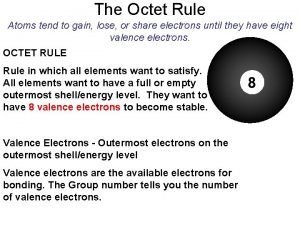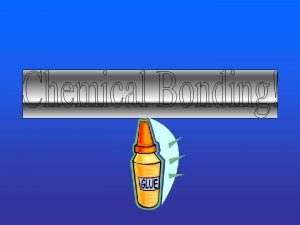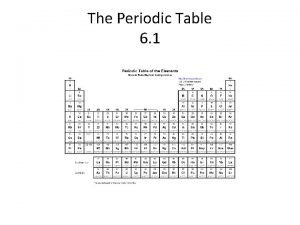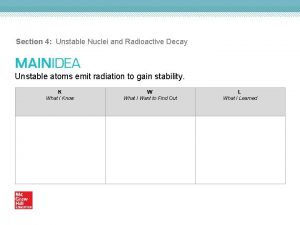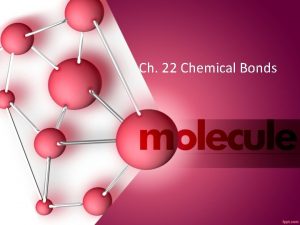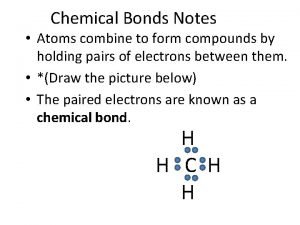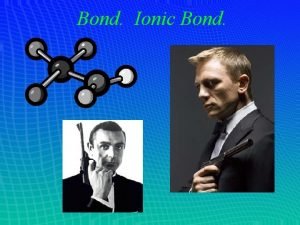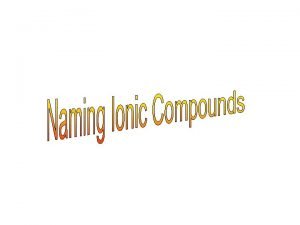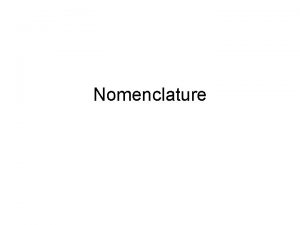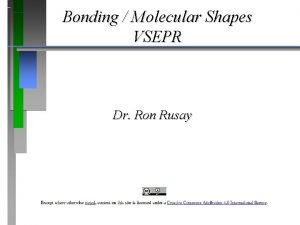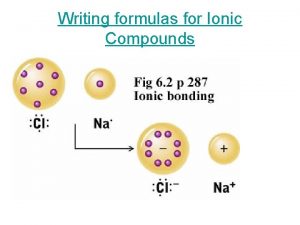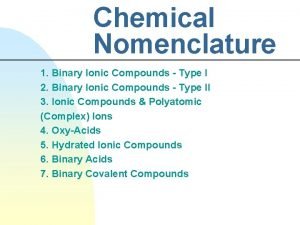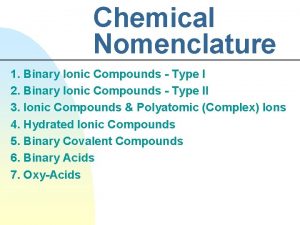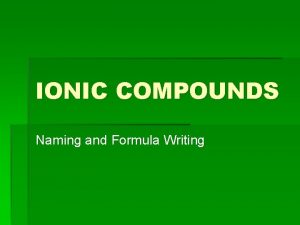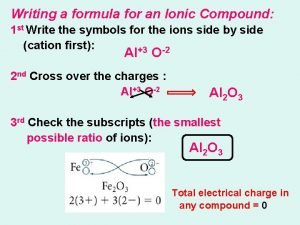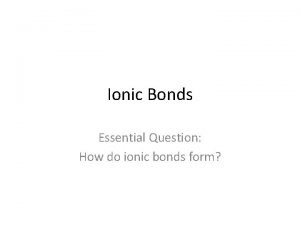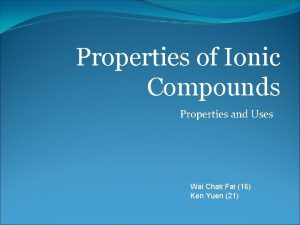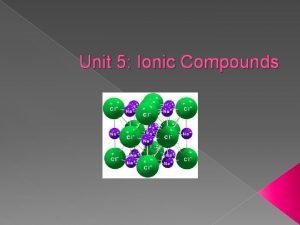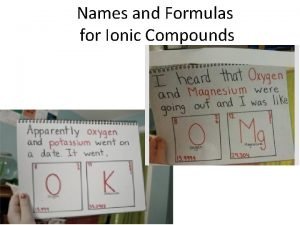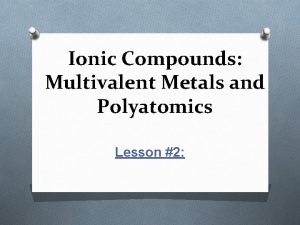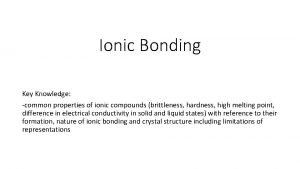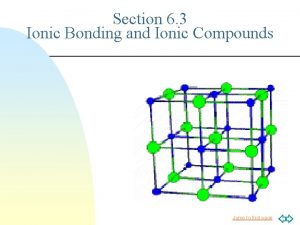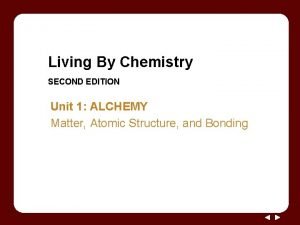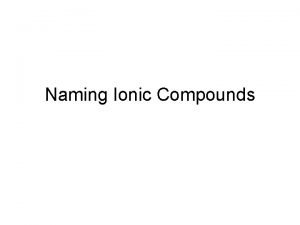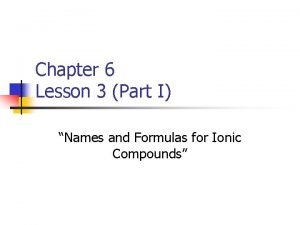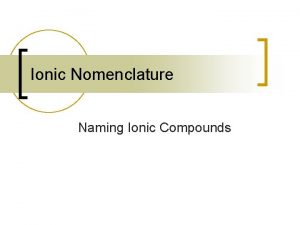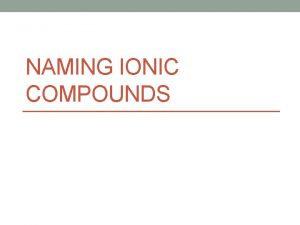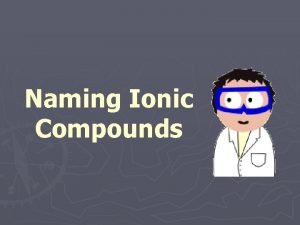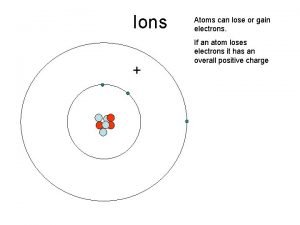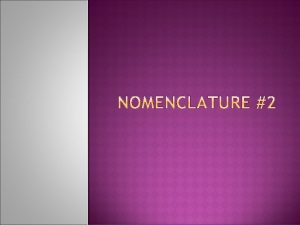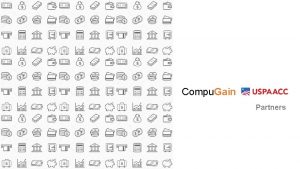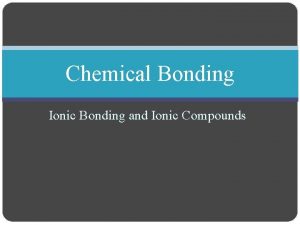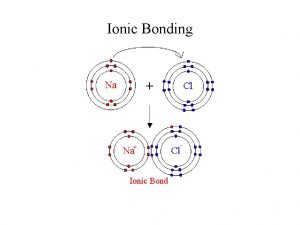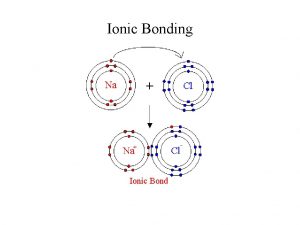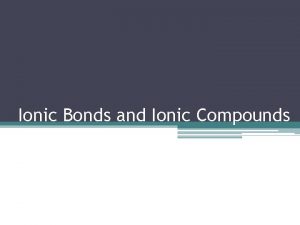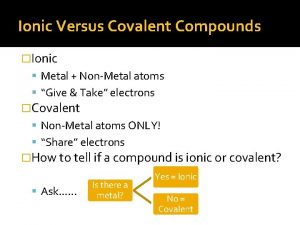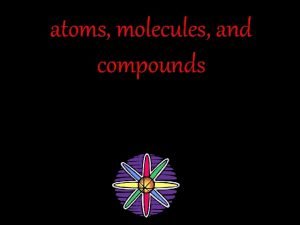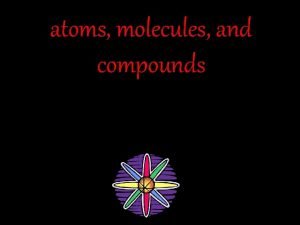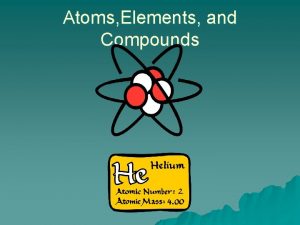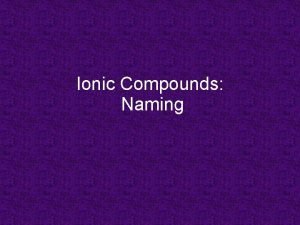IONIC COMPOUNDS IONIC COMPOUNDS Atoms gain or lose













































- Slides: 45


IONIC COMPOUNDS

IONIC COMPOUNDS • Atoms gain or lose electrons to form ions • An ionic compound forms when electrons on metal atoms transfer to non-metal atoms, creating oppositely charged ions • Example: table salt: Na + Cl vid

Na + Cl • When sodium and chlorine atoms come together, they are electrically neutral. • When they get close enough, an electron transfers from the sodium TO the chlorine (recall that sodium has an extra electron in its valence shell and chlorine is short one) • This makes a positive sodium ion, Na + , and a negative chlorine ion, Cl -. animation

IONIC COMPOUNDS Ionic compounds exist as a solid in the form of an ionic lattice -A repeating pattern of positive and negative ions Animation So is a single grain of salt a pair of sodium and chlorine ions? ? No! In a single grain of salt there are billions of trillions of sodium and chloride ions.

IONIC COMPOUNDS - Example Na. F

IONIC COMPOUNDS – Example Na. Cl Note: In order to simplify the model of ionic bonding, a single atom of sodium and chlorine are shown. In reality, the chlorine atom would be bonded to another chlorine atom as part of the gas Cl 2. The sodium atom would be one of billions of trillions of sodium atoms bonded together as a solid. The combination of these substances is a complex reaction between the atoms of the two substances. The animation shows single separated atoms to illustrate the idea of how ions and ionic bonds are formed . © Middleschoolchemistry. com


USE THE WHITEBOARDS TO PRACTICE DRAWING A FEW IONIC COMPOUNDS Start by drawing the Bohr models of the atoms of each. Then draw the ionic compound. 1. Beryllium Oxide (Be. O) 2. Potassium sulphide makes sense? ) (how many of each

beryllium oxide Be. O The ratio of 1: 1 makes sense… 1 Be atom is required to “fill the holes” in the O atom

potassium sulphide K 2 S The ratio of 2: 1 makes sense… 2 K atoms is required to “fill the holes” in the S atom

PART A: NAMING IONIC COMPOUNDS

CHEMICAL NAME A chemical name indicates the elements present in the compound. Name has two parts: one for each type (+, -) of ion • 1 st part names the positive ion (called the cation) • The positive ion is always a metal in a compound containing 2 elements

CHEMICAL NAME • The 2 nd part names the negative ion (called the anion) • The negative ion is always a nonmetal in a compound containing 2 elements • The non-metal ion’s name always ends with the suffix “-ide”

NAMING IONIC COMPOUNDS A couple of examples: Mg. Br 2 • magnesium bromide Ag 3 N • silver nitride Sr 3 P 2 • strontium phosphide Na 2 O • sodium oxide

Practice a few…

SOLUTIONS

NAMING IONIC COMPOUNDS PART B: WRITING FORMULAS

Ionic Formulas: • contain symbols to identify each ion • show the relative number of ions in the compound (i. e. ratio) • shown as a subscript to the right of the element symbol magnesium bromine Mg. Br 2 No number means there’s 1 magnesium ion This means there’s 2 bromine ions

Ionic Formulas In an ionic compound the positive charges balance the negative charges Example Al 2 O 3 3+ 3+ ---- 222 ---- 6+ 6 - 2 aluminums to It takes ___ 3 oxygens balance ___

How to Write Chemical Formulas • First, WATCH the example of zinc nitride. • Then, there’ll step-by-step instructions with the example to record into can record into your notes.

Writing Ionic Formulas: Example 1 Example: zinc nitride Zinc has a charge of 2+ Nitrogen has a charge of 3 - 2+ 2+ 6 It takes 3 zincs to balance 2 nitrogens Zn 3 N 2 33 - 3 -

Example: ü Step 1: Put symbols of each Zinc nitride element together. Leave a tiny 2+ 3 - 2+ 2+ 3 - 6+ 6 - Zn 3 N 2 It takes 3 zincs to balance 2 nitrogens space between for any subscripts ü Step 2: Figure out ratio needed to balance the charges on the metal and non-metal (how many of each do you need? ) ü Step 3: Include subscripts to the right of each element. If there is “ 1”, do not include that. Note: NO charges should appear in a compound. Compounds are neutral!!

Writing Ionic Formulas: Example 2 Example: magnesium chloride Mg has a charge of 2+ Cl has a charge of 1 - 2+ 2+ 2 11 - It takes 1 magnesium to balance 2 chlorines Mg. Cl 2 1 -

Practice a few… : s n o i t u l So

But wait, a shortcut exists! Example: Zinc nitride Zn 2+ Zn 3 N 3 - N 2 Zn 3 N 2

One more example: Calcium oxide Ca BUT… for ionic compounds we SIMPLIFY because it’s a ratio (just like in math) 2+ O Ca 2 O 2 Ca 2 O 2 2 - Ca. O

Practice a few…

SOLUTIONS

COMPOUNDS WITH MULTIVALENT METALS

Multi-Valent Metal Compounds Many important metals are multivalent • “multi” means many • “valent” refers to the capacity to bond (think about the valence shell…) So it means that the element has many ways to bond Multivalent metals can form 2 or more different positive ions with different ion charges

Example: Iron has two ion charges: 3+ and 2 as either. -The periodic table shows the most charge first --> Fe 3+ is more common than Recall: metals are blue ones here. In ionic compound, w name the metal fir

When we’re talking about multivalent metals, we need make sure we’re clear which ion form we’re talking about. To do this, we use Roman Numerals We would use Roman Numerals for copper (Cu) because it can have a charge of either 2+ or 1+ as an ion, and we’d need to specify which one We wouldn’t use Roman Numerals for calcium (Ca) because it always has a charge of 2+ as an ion So how do we know which one? ?

How to Write and Say Them… Examples Fe 3+ Written: iron(III) Pronounced “iron three” Fe 2+ Written: iron(II) Pronounced “iron two” Pb 4+ Written: lead(IV) Pronounced “lead four” Cu+ Written: copper(I) Pronounced “copper one”

PART A: WRITING FORMULAS WITH MULTIVALENT METALS

Writing Chemical Formulas w/ Multivalent Metals • The Roman Numeral after the metal will tell you which ion charge to use Example: Chromium fluoride Cr+3 or Cr+2 ? ? F-1 Example: Chromium(III) fluoride Cr+3 Cr. F 3 F-1

copper(I) iodide • Cu. I Writing Formulas of Multivalent Ionic Compounds Try some tin(II) nitride • Sn 3 N 2 iron(II) phosphide • Fe 3 P 2 examples: tin(IV) nitride • Sn 3 N 4

Practice a few…

Solutions

PART B: NAMING COMPOUNDS WITH MULTIVALENT METALS

NAMING COMPOUNDS WITH MULTIVALENT METALS It’s important EVERY time you write the metal in the compound, you stop to CHECK if it’s multivalent!! • If it IS, you need to include the Roman Numeral • If it IS NOT multivalent, do NOT include Roman Numeral!

No Likely

Examples Cu 3 P copper(I) phosphide ? y? Mn. O 2 Wh manganese(IV) oxide Mn+4 and O 2 - Mn 2 O 4 which simplifies to Mn. O 2 It’s not Mn+2 and O 2 - Mn 2 O 2 which simplifies to Mn. O

Practice a few…

Solutions
 Win win win lose lose lose
Win win win lose lose lose Win-win win-lose lose-lose
Win-win win-lose lose-lose Think win-win real life examples
Think win-win real life examples Aluminum chloride charge
Aluminum chloride charge Win win situation examples conflict resolution
Win win situation examples conflict resolution Habit 4: think win-win examples
Habit 4: think win-win examples Ionic vs covalent bonding venn diagram
Ionic vs covalent bonding venn diagram Mrs_coyle
Mrs_coyle Does carbon gain or lose electrons
Does carbon gain or lose electrons Gain lose electrons periodic table
Gain lose electrons periodic table Unstable nuclei and radioactive decay
Unstable nuclei and radioactive decay Compared to atoms of metals, atoms of nonmetals generally
Compared to atoms of metals, atoms of nonmetals generally Mixture of compounds diagram
Mixture of compounds diagram Is o2ionic or covalent
Is o2ionic or covalent Section 1 atoms elements and compounds
Section 1 atoms elements and compounds Do atoms combine to form compounds
Do atoms combine to form compounds Chemistry in biology section 2 chemical reactions
Chemistry in biology section 2 chemical reactions Chapter 6 section 1 atoms elements and compounds
Chapter 6 section 1 atoms elements and compounds Ionic bonds are always formed between ____
Ionic bonds are always formed between ____ Binary ionic compounds
Binary ionic compounds How are ionic compounds held together
How are ionic compounds held together Naming compounds
Naming compounds Vsepr
Vsepr 5 ionic compounds
5 ionic compounds Ternary ionic compounds
Ternary ionic compounds Type 1 binary compounds
Type 1 binary compounds Rs chemical name
Rs chemical name Example of ionic compound
Example of ionic compound Predicting and naming ionic compounds
Predicting and naming ionic compounds Ionic compounds containing polyatomic ions
Ionic compounds containing polyatomic ions How to write an ionic compound formula
How to write an ionic compound formula Why do ionic bonds form crystals
Why do ionic bonds form crystals Ionic compounds containing transition metals
Ionic compounds containing transition metals Chemistry chapter 7 ionic and metallic bonding
Chemistry chapter 7 ionic and metallic bonding Ionic compound
Ionic compound Cations e anions
Cations e anions Section 3 names and formulas for ionic compounds
Section 3 names and formulas for ionic compounds Is titanium multivalent
Is titanium multivalent Properties of ionic lattices
Properties of ionic lattices Molten ionic compounds
Molten ionic compounds What happens when a molten ionic compound is electrolysed
What happens when a molten ionic compound is electrolysed Ionic compounds
Ionic compounds Lesson 20 getting connected ionic compounds
Lesson 20 getting connected ionic compounds Stock system naming
Stock system naming Ternary ionic compounds
Ternary ionic compounds Molecular compounds def
Molecular compounds def



